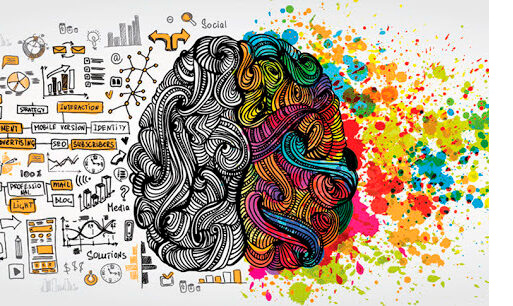One of the areas of knowledge most favored by the advancement of studies on the brain is education. Increasingly, researchers use recording and imaging techniques to study, from intrauterine life, how neurological development relates to fundamental functions for human beings to fully develop. By Carla Tieppo.
AUTHOR: CARLA TIEPPO is a neuroscientist, PhD in sciences from the University of São Paulo (USP) and professor at the faculty of medical sciences of Santa Casa de São Paulo and the Faculty of Psychology of the Pontifical University. (PUC) of São Paulo. Coordinator of the postgraduate course in neuroscience applied to santa’s education. Casa, is a pioneer in extension courses in neuroscience no. Brazil; is at the head of the Inétita Group.

Immensely more complex than that of other animals, our brain developed throughout its evolution the ability to uniquely perform complex functions such as consciousness, language, inibitory control, conscious processing of emotions and others equally impressive. The human sciences, responsible for producing much of the observations and theories about the mental processes related to the acquisition of these capacities, are slowly approaching neuroscientific knowledge to broaden understanding of the subject. Recently, for example, British teachers signed a motion calling on the Uk government to include neuroscience content in training courses so that future professionals can better understand the mental processes involved in learning.
The fact is that the number of children affected by learning disorders grows year after year and the expansion and deepening of knowledge in this area favor a more accurate diagnosis. Obviously, we cannot help but think that the changes we have gone through in the last 20 years in relation to the way our society is organized are possibly not one of the causes of this vertiginous increase in diagnoses of attention deficit, hyperactivity, conduct disorders, dyslexias, dyscalculias, among others. In any case, neuroscience can contribute to the evolution of pedagogical practices that allow the individual to develop, bringing him closer to the maximum manifestation of his potentials and in view of increasing demands of the contemporary digital and virtual age.
(WHO DOES NOT CRY DOES NOT BREAST: soon after birth, the baby’s brain structures are in full working order and already allow him to direct his behavior to get what he needs; sometimes it means simply falling into an inconsolable cry)

PERCEPTION AND ATTENTION:
One of the nerve points of the child’s development is at the beginning of his life. It is very important that in the first months the baby experiences an absolute relationship with his caregivers because the main occupation of the nervous system at this stage is to dedicate himself to his survival. The brain structures that are fully functioning during the period of birth allow the baby to direct his behavior to obtain what he needs – even if it simply means falling into an inconsolable cry. The development of the cerebral cortex will only occur at its maximum potential if the child is free of his commitments to survival and can venture to discover the new. According to researcher Helen Neville and her collaborators at the Brain Development Laboratory at the University of Oregon’s Center for Cognitive Neuroscience, the attention-grabbing function is developed by acquiring three brain capacities that occur at different times of child development. First, the baby needs to direct attention to an object, using the cortex. Before that, its behavior is strongly directed by sensory stimuli (especially olfactory) associated with food, heat and comfort. This more primitive dynamic, essential for survival, is related to the functions of areas located below the cerebral cortex that direct behavior to survival: the smell, face, sinus and thermal comfort of the mother are desired and sought after. For the baby to direct his attention to an object, his primary needs need to be sated. Moreover, this cortical orientation of attention seems to be possible only when it reaches a certain degree of maturation in the function of the cortical areas responsible for the processing of the different sensory stimuli. This interest may be related to colors, movements, or sounds. Attention will remain on the object only as long as it is able to keep sensory processing regions on enabled. For this reason, objects with unprecedented characteristics will always receive more attention. Brain function is qualifying stimuli between known and new – and associating the identified object with sensations, especially emotional ones. After learning to direct attention, a new challenge is to be able to keep attention directed to a focus for longer. This also depends on the development of the cerebral cortex, especially the structures of the frontal cortex closely related to the planning of the individual’s actions. Thus, at the extreme of this capacity we can observe the child diving deep into certain activities and being completely abstracted from the rest. For this reason, environments with a wealth of stimuli can be very interesting. However, in excess they may be enemies of the development of sustained attention. The third aspect to be developed is the ability to balance the previous two processes. The anterior cingulate cortex uses information from emotional processing (emotional valence) to promote an attentional control that is able to account for new stimuli, but can also abstract from them to devote itself to the most time-consuming interaction in a longer process – as if to hold on to a story. Working with laboratory animals, zootechnical doctor Wayne Bryden and his collaborators at the University of Queensland in Australia were able to demonstrate that the anterior cingulate cortex is directly related to the detection of predictive errors. Thus, a reward associated with a task may be better or worse than expected, and the anterior cingulate cortex will be strongly activated when it does. In children, this process can mean that surprise and different outcome can draw a lot of attention. Also the anterior cingulate cortex can help eliminate distracting elements. Neuroscientist Daniel Weissman, director of the Laboratory of Cognitive Attention and Control in Michigan, demonstrated through functional magnetic resonance imaging that dorsal regions of the anterior cingulate cortex are especially activated when the individual needs to focus on an event but is under pressure from other stimuli. In addition, this region is located at the interface between the emotional stimuli and the frontal cortex, in a position considered strategic
SLEEP AND MEMORIES: Another important issue for learning processes is the ability to memorize – and when considering this process, we do not refer to decorating. Memorization involves different steps that culminate in information storage. What differentiates learning from decorating is the time that information can remain sufficiently “activated” to be evoked. By acquiring information that may be used in the future, the child stores the content in the form of long-term memory. One of the most important advances in neuroscience is precisely in understanding the relationship between sleep and long-term memory. Several animal experiments have shown that during one of the sleep steps, the so-called Rapid Eyes Movements (REM) phase, a very old part of our cortex, the hippocampus, seems to work with the cortex for longer information storage. This transfer does not occur for any type of data, but for those to whom the hippocampus has been especially sensitized, either by the emotional content they contain, or by the repetition with which they were presented – hence the importance of memorizing. Our night’s sleep is divided into two main steps. In one of them, the brain is in a state of activity called the slow-wave phase, in which, it is believed, the less activated neural circuits allow metabolic recovery of neurons. During the first hours after we fall asleep, we remain in this modality, and as the sleep time gets longer, these periods are replaced by longer-lasting episodes of fast waves (REM). There may be the explanation for the fact that in the periods in which we are producing and strengthening new connections and nerve circuits, that is, in childhood, our need for daily hours of sleep is also greater. Thus, one of the most important learnings we can draw from our neuroscientific knowledge is that our children need to get a lot of sleep and have quality sleep. In this sense, routines that favor the establishment of an adequate rhythm of sleep are strongly recommended.
IN THE AGE OF TECHNOLOGY: teachers need to divide to pay attention to several students, in an attempt to respond, interact and stimulate children who, accustomed to computers and tablets, no longer know how to wait)

READ, TELL AND PLAY:
Another aspect that is being lost in the new society is playful and varied physical activity. We chose to put our children in swimming lessons, martial arts, Olympic gymnastics and so many other body-oriented classes. On the other hand, there is also an increasing number of children who do not want to exchange the video game or the computer for these activities. The practice of targeted physical exercises favors discipline, but for this same reason it can become as tedious as the school’s exhibition classes. Several studies show that physical activity favors brain development and assists both children and adults in problem solving and decision making. However, playing freely develops new neural circuits at all times because play without pre-established norms can change, be invented, does not tire or bore but the fact is that, free or disciplined, physical activity helps the development of the cerebellum. Every kind of motricity needs this area of the brain to run accurately. This is not new, but what can modify the way we see the child’s motor development are discoveries of neuroscience that associate the development of the cerebellum with that of language, reading and writing and mathematical reasoning. After much controversy over the topic, in February this year researchers from various groups proposed a consensus on the role of the cerebellum in cognition. This area located at the anterior base of the brain has been called a “supervised learning machine”. The role of the cerebellum in cognition would be very similar to what it plays in acquiring so-called ballistic movements. Researcher Jeremy Schmahmann, professor of neurology at Harvard University’s school of medicine, had previously considered that the cerebellum performed functions such as strength, rhythm, and accuracy of movement in the same way it regulated the speed, consistency, and adequacy of emotional and cognitive processes. By detecting errors in execution, the cerebellum selects circuits that approximate the intended realized movement, promoting its automation. If we consider that process automation is very important for language acquisition, reading and writing and for the production of mathematical reasoning, we can approach our teaching approaches to these functions of the knowledge we have about cerebellar neuronal circuitry and build more efficient learning models.
INHIBIT TO LEARN: Related to the prefrontal cortex, executive functions are associated with emotional maturation and complete their development only around the time the person turns 20. Throughout the development of children and adolescents, these functions need to be stimulated, even because the execution of many other necessary abilities in adulthood depends on them. It is those skills that help us to act in the world in a more adaptive way, that is, when we need to reason in the face of a problem, try to focus on an environment with other competitive stimuli or learn something new in school. Simple day-to-day activities, such as cooking, going to school, and shopping, also recruit these cognitive skills. Dr. And Developmental Neuroatomy Adele Diamond of British Columbia University points out that key executive functions, considered simpler, include cognitive flexibility skills, inhibition and working memory. The most complex executive functions include problem-solving capacity, reasoning and planning. Inhibition includes self-control and interference control, which requires the development of selective attention and cognitive inhibition. Working memory is the ability to keep multiple information “alive” in mind so that it is processed simultaneously. Cognitive flexibility is directly related to creativity and the possibility of thinking about alternative solutions. From these executive functions arise very desirable mental capacities, such as reasoning, problem solving and planning. International and national studies indicate the relationship between executive functions and school performance. Attentional control, for example, is one of the predictors of performance of preschool children in subjects that require mastery of language and mathematical son. The level of development of executive functions at the beginning of the schooling process is also an indicator of future performance. Students who start school life with higher levels of executive functions and self-regulation are easier to receive instructions, have less learning difficulties and demonstrate more pleasure and dedication in the proposed activities. Students with low development of these functions, in addition to presenting the opposite behavior, tend not to finish the tasks, abandoning them in half.
(PHYSICAL ACTIVITY assists both children and adults in problem solving and decision making; playing freely favors the development of new neural circuits)

PLACE OF JOY:
By the age of 6, children are already able to self-regulate in the physical, emotional and, partly, cognitive spheres. In this phase, the small ones are reactive, that is, they react spontaneously to stimuli. They can now postpone the realization of pleasurable things, stop aggressive behaviors and act in a positive way controlling their emotions. Cognitive regulation involves metacognition and reflexive thinking, being completely developed only at the end of elementary school. Before self-regulating, children are able to regulate the other, or to be regulated by other children. When someone else is breaking a rule, they do not realize what they themselves are making and apply the rules to others before adopting them for themselves. People’s emotional state can directly affect their executive functions. Studies show, for example, that the ability to maintain selective attention is impaired when we are sad, stressed, lonely and even out of physical shape. Stress inhibits executive functions, affecting school performance, as it decreases control of the prefrontal cortex and, in certain cases, the impression prevails that the person suffers from some disability or disorder such as attention deficit hyperactivity disorder (ADHD). Therefore, it is essential that the school is a space capable of promoting joy, tranquility, teamwork and cooperation. Similarly, children who have well-developed executive functions have better cortisol regulation, known as stress hormone, which makes them better deal with stressful situations. Investing in the development of strategies to develop executive functions, therefore, is an important way of promoting resilience in children.
(TO LEARN MORE: Neuroscience and education: myths and messages, Paul A. HowardJones, in Nature Reviews Neuroscience, 2014. Neuroscience and education – How the brain learns. Ramon M. Cosenza and Leonor. B. War. Artmed, 2011. The brain that learns – Lessons for education. Sarah-Jayne Blakemore and Uta Fritsch. Gradiva, 2009)

